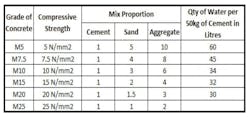Grades of Concrete for Foundations, Slabs, Columns, and Beams, Explained
Different proportions of the same four ingredients yield different strength mixes of concrete for structural and non-structural parts of a building
Lightly edited transcript:
Concrete is a mixture of cement, sand, aggregate, and water, which hardens with time. When we change the proportion of these components, the strength of concrete changes accordingly.
Just take the case of building construction.
In buildings, there are various structural elements—like footings, columns, beams, slabs. Depending on the type and height of the building, the strength of concrete required for constructing these elements changes, so it is necessary to choose the correct grade of concrete for each element of a structure.
The grade of concrete is nothing but a strength of a particular concrete mix: cement, sand, aggregate, and water after 28 days.
Grade of concrete is denoted by M, which stands for the mix. For example, an M5 grade has the proportions of 1 : 5 : 10, where one is the cement, five is the sand and ten is the coarse aggregate, based on volume or weight of materials.
At least three concrete cubes of 150mm x 150mm x 150mm are cast for each mix at 27 degrees Celsius and they are tested in a laboratory after 28 days. The mean strength is calculated, and that is the strength of concrete for that particular mix.
Why 28 days? The compressive strength of concrete increases quickly over time and tapers off relatively quickly too. It achieves 40 percent strength in three days, 90 percent strength in 14 days, and 99 percent strength in 28 days.
Concrete gains strength rapidly in the initial days—90 percent in only 14 days—and after that, concrete gains only 9 percent strength in the next 14 days. So the rate of strength-gain decreases. Because concrete gains 99 percent strength in 28 days, it is close to its final strength, so we use this strength at the base for our design and evaluation.
Coming back to grades of concrete, the table shows the proportion of cement, aggregate, sand, and water in different grades of concrete. For M5 grade, the mix proportion is 1 : 5 : 10. The quantity of water required is 60 liters.
In the same way, you can see the mix proportions of other grades of concrete up to M25. Up to M25, a nominal mix can be made for small-scale construction where concrete consumption is not high. For M 30 and above grades, Design Mix should be used.
You can see that as the strength of concrete increases, the cement content is constant in proportion but sand, aggregate, and water content are reduced. If you add more water to the concrete, its strength decreases and vice-versa. one more thing I have observed in most cases: the concrete grade of foundation and columns is higher than slabs and beams. Please note that this is not the general rule that's why I said in “most cases.”
Why?
- Foundations and columns are compression members whereas beams and slabs are tensile members.
- The load shall be transferred from slabs to beams, beams to columns, and columns to foundations.
- It is economical to reduce the grade of concrete for slabs and beams.
So, friends, I hope you have understood the different grades of concrete and their uses.
—This video is from Engineering Motive, a nifty little engineering channel on YouTube.
